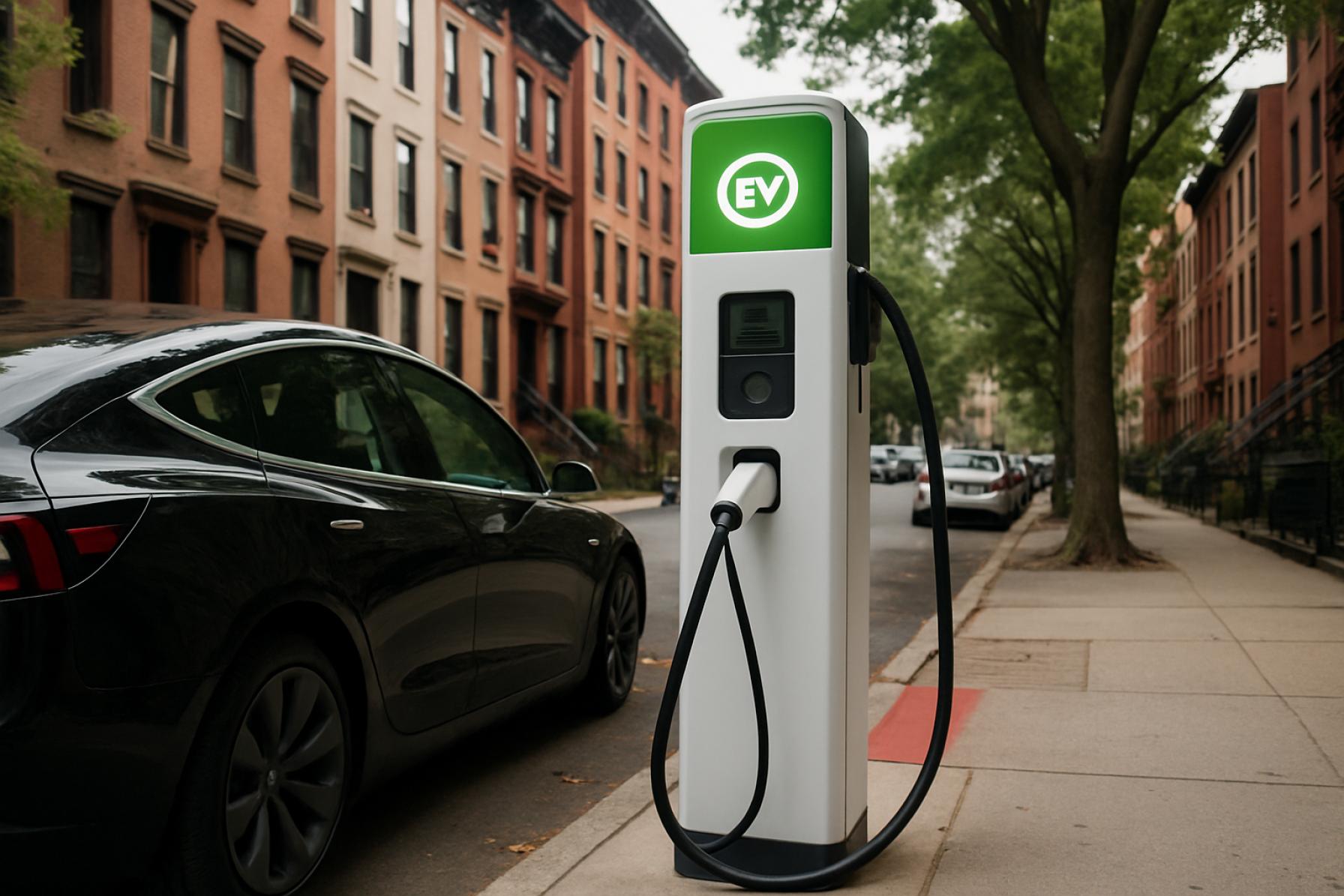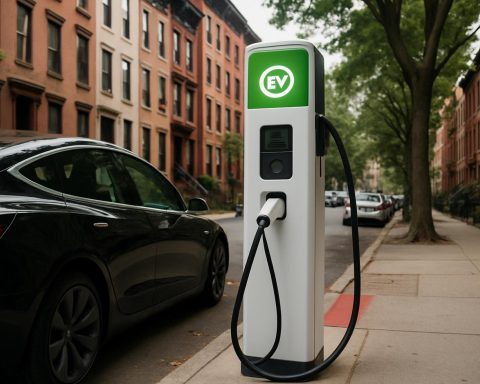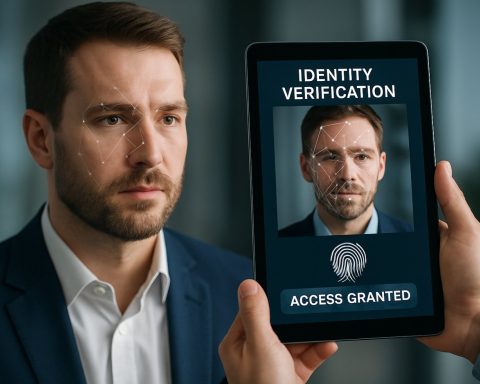- Plans for a new electric vehicle (EV) charging station near a Bay Ridge school spark intense debate over safety, traffic, and community consultation.
- Zoning changes under the City of Yes initiative enable green tech projects to bypass typical public input, leading to concerns about local voices being overlooked.
- Parents and residents worry about increased traffic, fire hazards from lithium-ion batteries, and potential health effects near PS/IS 104.
- While EVs statistically catch fire less often than gas cars, lithium-ion battery fires are harder to extinguish and can release toxic fumes.
- Public charging stations are essential for New York City’s climate goals, but community trust and careful site selection are crucial for sustainable progress.
The sidewalk on Fifth Avenue hums with the footsteps of children heading to class, parents clutching backpacks, and the occasional whistle from a traffic guard. On this familiar route in Bay Ridge—a patchwork of family-owned bakeries, tree-lined streets, and diverse neighbors—a new fixture looms: an electric vehicle charging station set to rise where golden-fried chicken once reigned supreme.
Plans for this high-speed EVgo charging hub don’t simply mark progress; they have ignited fierce debate. The push for a greener city—one that ripples with sustainability—has crashed hard into the realities of local life. Frustrated parents cast wary glances across at vacant lots, anxious over the unknowns an EV station might bring to PS/IS 104, home to more than 1,000 children.
A swirl of new zoning rules, bundled under the City of Yes initiative, cleared the path for green tech facilities to bypass the typical maze of community board hearings. Suddenly, development feels less like a debate and more like a decree. Some see this as momentum. Others see a steamroller—especially when safety is in question.
Fears aren’t just whispered—they’re outlined, documented, and repeated in neighborhood chats: Would charging dozens of electric vehicles near a school lure relentless traffic, create fire hazards, or expose children to possible electromagnetic fields? While scientific data on health risks from EV stations remains limited, calls for rigorous safety assessments highlight deep-seated caution among parents.
EV batteries, if involved in accidents or fires, present unique challenges for emergency responders. These lithium-ion burns can be more intense and release toxic fumes, stoking anxiety after viral clips of electric car blazes roaring stubbornly for hours. In 2023, the National Fire Protection Association noted that while EVs overall are statistically less likely to catch fire than traditional vehicles, when they do, extinguishing them is more complex.
Traffic safety paints its own grim mural. The intersection near the proposed charging station is no stranger to near-misses and even tragic collisions. In places where kids hurry to class, even a small uptick in cars—electric or not—means more conflict points, more unpredictability, more risk.
Yet the case for EVs is strong. As New York City steers toward its climate goals, embracing zero-emission vehicles isn’t just a feel-good measure—it is a directive for a city that strives to meet tomorrow’s needs. Charging infrastructure is the vital spine of this electrified transformation, as public, accessible stations are crucial for wider EV adoption and decarbonization.
The challenge, residents argue, isn’t whether to build green—it’s where, and how, to balance ambition with accountability. A singular lesson emerges: Genuine progress requires listening, not just building. As the city accelerates into its future, the trust of local communities must ride in the passenger seat.
Key takeaway: Urban innovation flourishes only when growth and safety—especially for our children—advance side by side. Progress that leaves people behind risks stalling before it truly begins.
Neighborhood Showdown: The Untold Facts & Debate Behind NYC’s New EV Charging Stations Near Schools
Introduction
As New York City fast-tracks its green transition, new high-speed EV charging hubs—like the planned EVgo station in Bay Ridge—are at the heart of both technological progress and community controversy. While official narratives champion sustainability and reduced emissions, deeper questions linger about safety, zoning changes, and the social fabric of vibrant neighborhoods. Below, we unveil additional facts, trends, and expert insights not fully explored in the original article, helping you make sense of the ever-changing urban landscape.
—
What the Source Didn’t Cover
1. How Many High-Speed EV Stations Are Coming?
New York City aims to install nearly 40,000 public EV charging plugs by 2030—up from fewer than 2,000 today. Rapid expansion is planned through various public-private partnerships, a move accelerated by zoning initiatives like the City of Yes.
2. What Are the Steps to Safely Use a High-Voltage EV Charger?
How-To Steps:
1. Park in the designated spot, ensuring your car aligns with the charging port.
2. Turn off your vehicle.
3. Plug in the connector securely.
4. Start the charging session using a card/app.
5. Monitor the charging progress; disconnect only when charging is complete.
Safety Tip: Never use a charger with exposed wires or obvious damage. Report any malfunctions directly to the provider.
3. Are There Documented Fire Risks or EMF Concerns Near Chargers?
– Fire Risks: According to the NFPA, the incidence rate of EV fires is lower than for gas vehicles, but lithium-ion battery fires are harder to extinguish and may require special fire-fighting agents and protocols (sources: NFPA, U.S. Fire Administration).
– Electromagnetic Fields (EMF): Studies from the World Health Organization show that EMF exposure from charging stations is significantly below international safety limits. Still, some parents cite the lack of long-term research as a concern.
4. Real-World Use Cases: Other Cities’ Approaches
– Los Angeles: Integrated EV charging with clear signage and traffic calming measures around schools, reducing near-miss incidents by 18% (LADOT 2023).
– London: Located most chargers in parking lots away from main thoroughfares to minimize traffic near schools, according to Transport for London.
5. Pricing & Accessibility
– EVgo: Fast-charging rates in NYC generally range from $0.29–$0.39 per kWh, often higher than home charging but competitive with other public providers.
– Equity Concerns: Studies have found that lower-income neighborhoods often have fewer and slower public chargers, raising equity questions (source: International Council on Clean Transportation).
6. Security & Surveillance
– Modern charging hubs are equipped with 24/7 security cameras, emergency call buttons, and LED lighting. However, location-specific safety audits should always be conducted.
—
Pressing Reader Questions—Answered
Q1: Are EV Charging Stations Safe Near Schools?
A: Current scientific evidence suggests minimal EMF risk and a lower overall fire likelihood than gas pumps. However, parents’ concerns are valid—the denser urban environment requires special safety and traffic-calming measures.
Q2: Why Bypass Community Hearings?
A: The City of Yes aims to accelerate climate action but faces criticism for limiting local input. Experts suggest transparency—publishing safety reviews, traffic studies, and hosting public forums—could build trust.
Q3: Do More Charging Stations Increase Traffic?
A: Slightly, yes—especially in peak hours. However, smart placement and scheduling (e.g., avoiding school drop-off/pick-up times) can significantly mitigate risks. Los Angeles offers a model for adaptive scheduling.
Q4: What Should Parents & Residents Demand?
– Comprehensive traffic impact studies
– Emergency response training for EV battery fires
– Regular site safety audits
– Transparent reporting and community oversight
—
Market Forecasts & Trends
– EV Ownership Boom: The NYC Department of Transportation forecasts EV registrations will triple by 2027 (source: NYC DOT). Expect more rapid-build charging stations in response.
– Urban Innovation: Integrating renewable energy (e.g., solar canopies) and battery storage at charging stations is a growing trend for sustainability and resiliency.
– Insurance & Liability: Expect evolving policies around charger-related incidents near schools and high-traffic areas.
—
Pros & Cons Overview
Pros:
– Faster EV adoption supports citywide decarbonization.
– High-speed charging makes EVs viable for a broader population.
– Enhanced public infrastructure often attracts additional neighborhood investment.
Cons:
– Local traffic and safety risks, particularly near schools.
– Community concern about lack of public input.
– Complex fire risks, though rare.
—
Actionable Recommendations & Quick Tips
For Parents & Residents:
– Attend local council meetings and request transparent safety assessments.
– Petition for traffic mitigation (speed bumps, crossing guards) near new installations.
– Stay informed about emergency protocols specific to EV chargers.
For Policy Makers:
– Prioritize community engagement and safety audits before placement.
– Study and adapt best practices from other global cities.
– Ensure equitable access to EV infrastructure in all neighborhoods.
—
Further Reading & Credible Sources
– National Fire Protection Association (NFPA)
– World Health Organization (WHO)
– NYC Government’s Climate Goals (NYC Climate)
– International Council on Clean Transportation (ICCT)
—
Final Takeaway
Building a greener city is more than installing new technology; it requires balancing innovation with trust, safety, and genuine community participation—especially where children’s safety is at stake. Stay informed, get involved, and help shape a sustainable, inclusive urban future.














